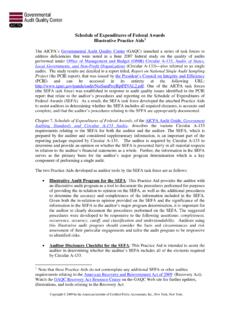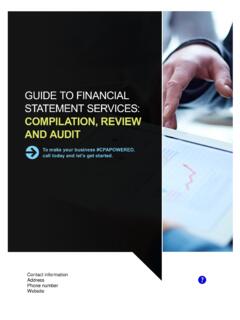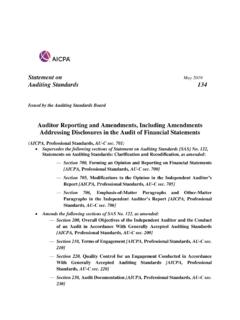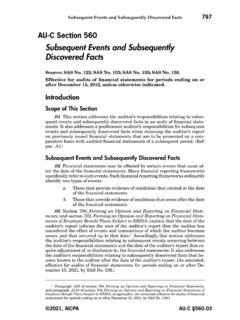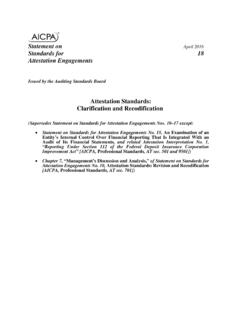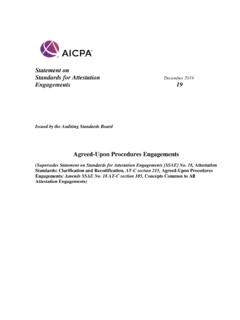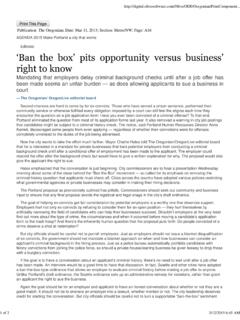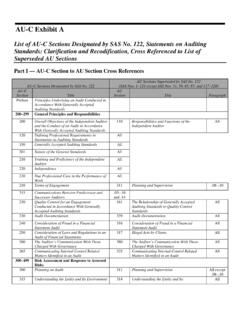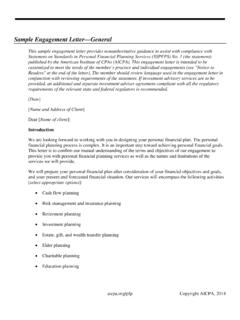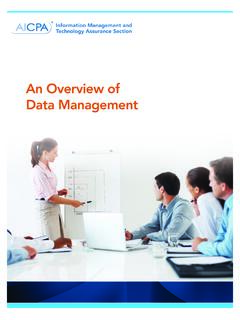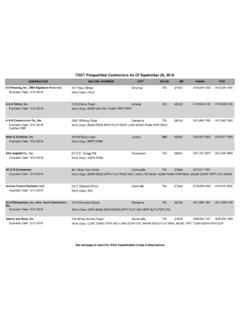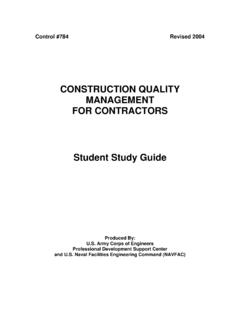Transcription of May 10, 2021 Construction Contractors Revised Sample ...
1 May 10, 2021. Construction Contractors Revised Sample Financial Statements Working Draft Appendix H. Sample Financial Statements This appendix is nonauthoritative and is included for informational purposes only. Gray shaded text in this appendix reflects guidance issued but not yet effective as of the date of this guide, September 1, 2021, but becoming effective on or prior to December 31, 2021, exclusive of any option to early adopt ahead of the mandatory effective date. Unless otherwise indicated, all unshaded text reflects guidance that was already effective as of the date of this guide. The following Sample financial statements of a nonpublic company Construction contractor are included for illustrative purposes only and are not intended to establish reporting requirements. The Sample finan- cial statements are designed to illustrate presentation for a non-public contractor that has adopted the guidance in FASB Accounting Standards Codification (ASC) 606, Revenue from Contracts with Cus- tomers, and due to effective dates has not adopted FASB ASC 842, Leases, and 326-20, Financial In- struments Credit Losses.
2 Contractors that are public business entities and those nonpublic business en- tities who have adopted ASC Topic 842 or Subtopic 326-20 should also consider other applicable guid- ance. The Sample financial statements do not include all of the accounts and transactions that might be found in practice. The notes indicate the subject matter generally required to be disclosed, but they should be expanded, reduced, or modified to suit individual circumstances or materiality considerations. In addition to the illustrative notes that are presented, some of which are more or less peculiar to con- struction Contractors , the notes to a Construction contractor 's financial statements should include infor- mation concerning other matters that are not unique to Construction Contractors , for example, subsequent events, pension plans, postretirement benefits other than pensions, postemployment benefits, stock op- tions, lease commitments, extraordinary items, accounting changes, and off-balance-sheet risks.
3 ACME Contractors Inc. and Subsidiaries Consolidated Balance Sheet December 31, 20X1 and 20X0. 20X1 20X0. Assets Current Assets Cash and cash equivalents Contracts receivable, net of allowance including unconditional retainage of $[ ] and $[ ] at December 31, 20X1 and 20X0, respec- tively fn 1. Contract assets, including conditional retainage of $[ ] and $[ ]. at December 31, 20X1 and 20X0, respectively fn 2. Capitalized costs to fulfill contracts Current portion of note receivable Prepaid expenses and other current assets Total Current Assets Investments and Long-Term Receivables Restricted cash deposits Equity method investment in joint venture Note receivable, less current portion fn 1. A receivable is defined in paragraph 4 of FASB ASC 606-45-10 as being a right to consideration that is not conditional upon any- thing other than the passage of time, and accordingly careful evaluation of retentions is necessary to determine whether such amounts should be classified within contracts receivable or within the contract's asset or liability (see paragraphs.)
4 142 .143 of chapter 2). fn 2. Under FASB ASC 606, certain contract specific assets are to be classified as contract assets. The FASB Master Glossary defines contract assets as An entity's right to consideration in exchange for goods or services that the entity has transferred to a customer when that right is conditioned on something other than the passage of time (for example, the entity's future performance). These amounts include what has often been referred to as costs and estimated earnings in excess of billings on uncompleted contracts prior to adoption of the guidance in FASB ASC 606, and retainage that is subject to conditions other than the passage of time that may have previously been classified within contracts receivable. The Financial Reporting Executive Committee (FinREC) recommends entities transition from using the term costs and estimated earnings in excess of billings on uncompleted contracts. That term closely aligned with the process of recognizing revenue based on the amount of gross profit earned on a contract for a period plus the costs incurred on the contract during the period as described in alternative B of paragraph 84 of FASB ASC 605-35-25 and then recognizing a contract asset when such amounts are greater than billings but it is not consistent with the process of recognizing revenue under FASB ASC 606.
5 Furthermore, such description of the contract asset includes the phrase in excess of billings but may include amounts that have been invoiced but are contingent upon something other than the passage of time. Entities can choose to utilize the term contract asset to describe such amounts but are not required to. FinREC believes commonly used acceptable alternatives to the term contract asset may include: Contracts in progress Work in progress Revenue earned in excess of amounts received or receivable Unbilled revenues Cash surrender value of officers' life insurance, net of policy loans Property, Plant and Equipment, net Other Assets fn 3. Goodwill Trademarks and other intangible assets Other long-term assets Deferred tax, net Total Noncurrent Assets Total Assets Assets of the consolidated variable interest entity of $[ ] and $[ ] at December 31, 20X1 and 20X0, respectively, can only be used to settle obligations of the consolidated variable interest entity, which include liabilities of $[ ] and $[ ].
6 At December 31, 20X1 and 20X0, respectively, for which the creditors do not have recourse to the general credit of the primary benefi- ciary which consolidates the variable interest entity. fn 4. Upon adoption of FASB ASU No. 2016-02, Leases (Topic 842), right of use assets will be included on the balance sheet, along fn 3. with a related lease liability. This table presents the balance sheet captions that may replace lease treatment under FASB ASC 840, Leases. (See footnote 17.). Assets Other Assets Right of use assets operating leases Right of use assets financing leases Liabilities and Stockholders' Equity Current Liabilities Current portion of operating lease liabilities Current portion of financing lease liabilities Noncurrent Liabilities Operating lease liabilities, net of current portion Financing lease liabilities, net of current portion fn 4. Paragraph 25 of FASB ASC 810-10-45 states that a reporting entity shall present each of the following separately on the face of the statement of financial position: a.
7 Assets of a consolidated variable interest entity (VIE) that can be used only to settle obligations of the consolidated VIE. b. Liabilities of a consolidated VIE for which creditors (or beneficial interest holders) do not have recourse to the general credit of the primary beneficiary. Alternative presentations to meet the disclosure requirement may include (1) separate line items for amounts meeting the criteria above or (2) parenthetical disclosure of applicable amounts on each asset and liability line item as applicable. Liabilities and Stockholders' Equity Current Liabilities Line of credit Current maturities of long-term debt Accounts payable and accrued expenses, including $[ ] and $[ ]. of subcontractor retainage payable at December 31, 20X1 and 20X0, respec- tively Contract liabilities net of conditional retainage of $[ ] and $[ ]. at December 31, 20X1 and 20X0, respectively fn 5. Current maturities of capital lease obligations fn 6. Accrued losses on uncompleted contracts Total Current Liabilities Noncurrent Liabilities Long-term debt, net of current maturities Capital lease obligations, net of current maturities fn 7.
8 Payable to affiliates and other related parties, net of current maturities Other long-term liabilities Total Noncurrent Liabilities Total Liabilities Stockholders' Equity fn 5. Under FASB ASC 606, certain contract-specific liabilities are to be classified as contract liabilities. The FASB Master Glossary defines contract liabilities as An entity's obligation to transfer goods or services to a customer for which the entity has received con- sideration (or the amount is due and included in receivables) from the customer. These amounts include what has often been referred to as billings in excess of costs and estimated earnings on uncompleted contracts prior to the adoption of the guidance in FASB. ASC 606and customer deposits. FinREC recommends entities transition from using the term billings in excess of costs and estimated earnings on uncompleted con- tracts. While that term closely aligned with the process of recognizing revenue based on the amount of gross profit earned on a con- tract for a period plus the costs incurred on the contract during the period as described in alternative B of paragraph 84 of FASB ASC.
9 605-35-25 and then recognizing a contract liability when such amounts are less than billings, it is not consistent with the revenue recognition process under FASB ASC 606. Furthermore, such description of the contract liability includes the term billings but may include amounts that are contingent upon something other than the passage of time. An entity can choose to use the term contract liabilities to describe such amounts but is not required to. FinREC believes commonly used acceptable alternatives to the term contract liability may include: Contracts in progress Work in progress Deferred revenue Payments received or receivable in excess of revenues earned fn 6. See footnote 3. fn 7. See footnote 3. Common stock, no par value, [ ] shares authorized, [ ] is- sued and outstanding Additional paid-in capital Retained earnings Total Controlling Interest Stockholders' Equity Noncontrolling interest in subsidiary Total Stockholders' Equity Total Liabilities and Stockholders' Equity The accompanying notes are an integral part of these consolidated financial statements.
10 ACME Contractors Inc. and Subsidiaries Consolidated Statement of Operations fn 8. for the Years Ended December 31, 20X1 and 20X0. 20X1 20X0. Contract Revenue Cost of Contract Revenue Gross Profit (Loss). Operating Expenses fn 9. Selling General and administrative Gain on sale of property and equipment Operating Income (Loss). Other Income (Expenses). Rental income Interest income Interest expense fn 10. Miscellaneous income, net Total Other Expenses, net Net Income (Loss) Before Provision for Income Tax Expense Provision for Income Tax Expense Net Income (Loss). Net Income (Loss) Attributable to Noncontrolling Interest Net Income (Loss) Attributable to Controlling Interest The accompanying notes are an integral part of these consolidated financial statements. fn 8. If neither period presented has a net loss, the statement may be titled Consolidated Statement of Income.. fn 9. Upon adoption of FASB ASU No. 2016-02, operating lease expenses should be included in income from continuing operations in the income statement.
